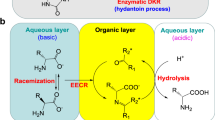Abstract
Kinetic resolutions play important roles in industrial biotransformations for production of optical pure compounds from racemic substrates. A simple method, based on enantiomeric excess of both substrate (ee S) and the corresponding product (ee P), was developed for determination of concentration of enantiomers in kinetic resolution. Since only relative quantity (ee) was required in the proposed method, calibration and cumbersome quantitative sample handling can be avoided and analytical accuracy can be greatly improved.

Similar content being viewed by others
Reference
Birnbaum J, Kahan FM, Kropp H, Macdonald JS (1985) Carbapenems, a new class of beta-lactam antibiotics: discovery and development of imipenem/cilastatin. Am J Med 78(Suppl. 6A):3–21
Berti F, Felluga F, Forzato C, Furlan G, Nitti P, Pitacco G, Valentin E (2006) Chemoenzymatic synthesis of diastereomeric ethyl γ-benzyl paraconates and determination of the absolute configurations of their acids. Tetrahedron: Asymmetry 17:2344–2353
Chen C-S, Fujimoto Y, Girdaukas G, Sih CJ (1982) Quantitative analyses of biochemical kinetic resolutions of enantiomers. J Am Chem Soc 104:7294–7299
Kotik M, Brichac J, Kyslík P (2005) Novel microbial epoxide hydrolases for biohydrolysis of glycidyl derivatives. J Biotechnol 120:364–375
Rakels JLL, Straathof AJJ, Heijnen JJ (1993) A simple method to determine the enantiomeric ratio in enantioselective biocatalysis. Enzyme Microb Technol 15:1051–1056
Reetz MT (2001) Combinatorial and evolution-based methods in the creation of enantioselective catalyst. Angew Chem Int Ed 40:284–310
Romano D, Ferrario V, Molinari F, Gardossi L, Montero JMS, Torre P, Converti A (2006) Kinetic resolution of (R, S)-1,2-O-isopropylideneglycerol by esterification with dry mycelia of moulds. J Mol Catal B: Enzymatic 41:71–74
Shaw NM, Robins KT, Kiener A (2003) Lonza: 20 years of biotransformations. Adv Synth Catal 345:425–435
Straathof AJJ, (1997) The enantiomeric ratio: origin, determination and prediction. Enzyme Microb Technol 21:559–571
Straathof AJJ, Panke S, Schmid A (2002) The production of fine chemicals by biotransformations. Curr Opin Biotechnol 13:548–556
Straathof AJJ, Rakels JLL, Heijnen JJ (1995) Mass balancing in kinetic resolution: calculating yield and enantiomeric excess using chiral balance. Biotechnol Bioeng 45:536–538
Ward TJ (2002) Chiral separations. Anal Chem 74:2863–2872
Wielechowska M, Plenkiewicz J (2005) Lipase-catalyzed separation of the enantiomers of 1-substituted-3-arylthio-2-propanols. Tetrahedron: Asymmetry 16:1199–1205
Xu Y, Xu JH, Pan J, Tang YF (2004) Biocatalytic resolution of glycidyl aryl ethers by Trichosporon loubierii: cell/substrate ratio influences the optical purity of (R)-epoxides. Biotechnol Lett 26:1217–1221
Zheng RC, Zheng YG, Shen YC (2007) A screening system for active and enantioselective amidase based on its acyl transfer activity. Appl Microbiol Biotechnol 74:256–262
Zimmermann V, Beller M, Kragl U (2006) Modelling the reaction course of a dynamic kinetic resolution of amino acid derivatives: identifying and overcoming bottlenecks. Org Process Res Dev 10:622–627
Acknowledgements
This work was supported by the Major Basic Research Development Program of China (No. 2003CB716005), Chinese national programs for high technology research and development (No. 2006AA02Z241) and Doctor Program of High Education of China (No.20051033701)
Author information
Authors and Affiliations
Corresponding author
Rights and permissions
About this article
Cite this article
Zheng, RC., Zheng, YG. & Shen, YC. A simple method to determine concentration of enantiomers in enzyme-catalyzed kinetic resolution. Biotechnol Lett 29, 1087–1091 (2007). https://doi.org/10.1007/s10529-007-9358-x
Received:
Revised:
Accepted:
Published:
Issue Date:
DOI: https://doi.org/10.1007/s10529-007-9358-x




